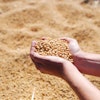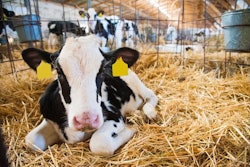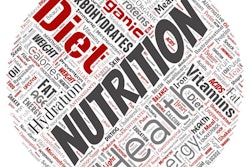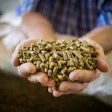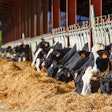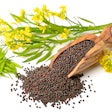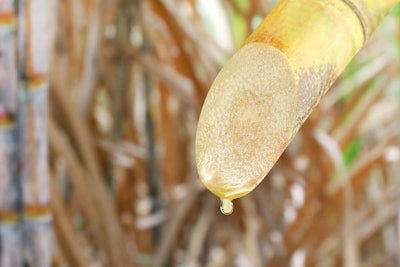
Molasses, either from sugar beets or sugar cane, is a common enough ingredient throughout most of the world. In fact, it is an indispensable ingredient in ruminant diets, and perhaps this widespread usage has removed it from feeds for other species – pigs in particular.
In the past, when sweetness in piglet diets was prioritized higher than it is today, molasses was used as a less expensive alternative to table sugar. But the advent of artificial sweeteners has removed even this last chance for molasses to find its way into modern piglet feeds.
Molasses has many properties that make it difficult to utilize as an ingredient. First, it is neither dry nor liquid; it is a semi-viscous liquid that freezes in cold temperatures. Thus, it requires not only a tank for its storage and a spraying mechanism for its application in feed while mixing, but it also needs a heating system to prevent it from becoming solid.
Used at high concentrations, it makes the feed sweet, but also makes pellets friable, something totally undesirable to human buyers. Also, a darker pellet – the consequence of using high levels of molasses – can look like burnt pellets, and too much pelleting heat can actually burn high-molasses pellets. Less importantly, molasses tends to result in dark fecal matter appearance, something that makes things more “visible” and thus can alert human handlers.
In addition, too much sugar (molasses contains sugar, glucose and fructose in equilibrium) is a laxative so, in markets where soft fecal matter is considered (erroneously) a progenitor for pathogenic diarrhea, molasses finds little understanding. That molasses contains too much potassium (another laxative-like nutrient) and is harmful has been rebuffed long ago, but the damage in perception remains. In fact, high-potassium feeds are required when soybean products are not or cannot be used in piglet feeds.
How lactose figures in
To understand how molasses can add value to piglet diets, we must realize that piglets require and respond linearly to lactose in their initial feeds. This has been proven unequivocally at The Ohio State University (Table 1). After all, lactose is the major, if not only, sugar in sow’s milk. So, post-weaning diets have been traditionally high in lactose, which is also an equally mild laxative nutrient/ingredient.

To understand how molasses can add value to piglet diets, we must realize that piglets require and respond linearly to lactose in their initial feeds.
But piglets do not just need lactose. They respond equally well to many other simple sugars, something well known since the 1950s, and proven under more conventional/commercial conditions in the late 1990s at Kansas State University (see Figure 1).

Growth and feed intake in piglets fed high-molasses diets. There were no treatment effects at P<0.05 value.
Thus, the first benefit molasses can bring into a piglet post-weaning feed is freedom from the need to use lactose. This is particularly important in regions where milk products are expensive or just unavailable. In fact, molasses can replace 100% lactose without any problems, as long as it is done correctly.
Benefits of sweetness
We should not discard the role of offering a sweet diet to young pigs. After all, sweetness is naturally associated with high-energy feeds. Thus, one can reasonably argue that once a sweet ingredient like molasses is used at sufficient levels, other artificial sweetness might become redundant.
Considering the cost of modern flavors, this might not be such a bad hypothesis to test. And, for those who argue that modern flavors are more than taste, it can be reminded that molasses-based diets are characterized by a distinct “caramel” aroma that appears to appeal greatly to young pigs. This mild expression of the Maillard reaction process in early piglet feeds remains another aspect that awaits validation, although commercial evidence is supporting the notion.
More fines can be an advantage
That high-molasses diets result in more fines, due to more fragile pellets, is an advantage and not a negative aspect. The problem has been created by misinterpreted results of tests conducted with heavier pigs and then extrapolated into weaned pigs. In fact, other research indicated that young pigs prefer soft pellets – even with excessive fines in them – over hard, clean, perfect pellets that we all prefer to see in feeders. And, molasses-based pellets are soft, tasty and tacky. This last aspect is something overlooked, but it was widely recognized by the previous generation of nutritionists.
Weaned pigs (or those offered a creep feed for the first time) will end up eating whatever sticks to their snouts after they investigate it by pushing it around. It works even better if the feed is in meal form.
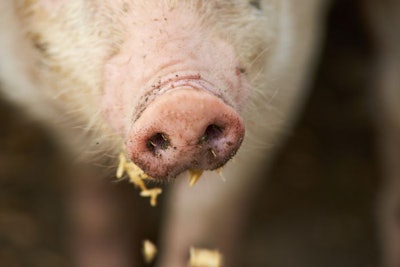
Fines in pelleted feed for piglets can be an advantage, as weaned pigs will end up eating whatever sticks to their snouts after they investigate it by pushing it around. (elenavolf | Bigstock.com)
Laxative effect
As for the laxative effect, it remains, and it gets worse as molasses concentration increases. Gut leakage (water entering the lumen due to osmosis) is not harmful, but some prefer rock-hard fecal matter over high-feed intake and excellent growth. Both cannot be achieved unless the feed becomes prohibitively expensive. Nevertheless, the removal of antibiotics has caused modern diets to be denuded of much of their previous lactose levels and, as such, any replacement with molasses will not bring about any significant alteration in fecal matter consistency, unless feed intake increases.
Here, along with the change of fecal matter color, is a topic on which we need to re-educate our pig producers and especially our veterinarians, who prefer to be safe (constipation) than sorry (confusing soft fecal matter with pathogenic diarrheas). It does not help that most veterinary schools devote but a couple of courses on nutrition in a five-year curriculum, whereas nutrition plays a major role on economics, as well as health and well-being.
Investing in molasses-handling equipment
It should be noted that the initial investment of installing molasses-handling equipment should be weighed against the potential benefits. It is easier to do so if the feed mill works for the benefit of an integrator. It is less so when such feeds need to be sold in the open market as the technical/sales team will require to educate producers, whereas the management team will have to be prepared to share some of the savings with their customers – not always what commercial feed mills look forward to.
But, the higher the level of molasses usage, the quicker will be the payback to the original investment and the higher will be the cost-savings benefit. Of course, things can go wrong at any stage, and this is why employees prefer to steer away from the unknown, at the expense of ownership’s benefits.
Molasses can and should become a staple ingredient used at high levels in diets for young pigs. The reason why it is not there is because it requires daring and work. This does not come easily, but when done correctly, it works.
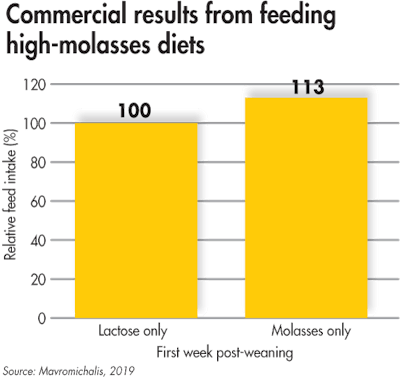
Commercial results from feeding high-molasses diets.

